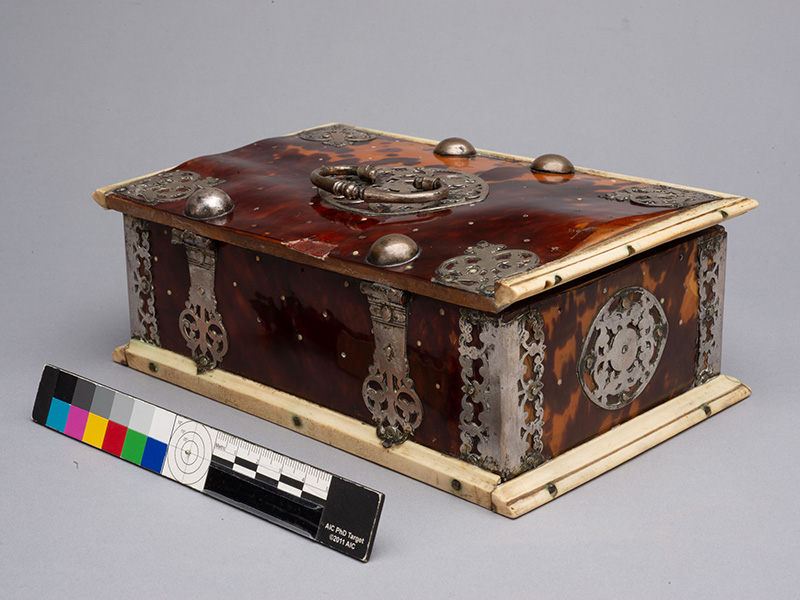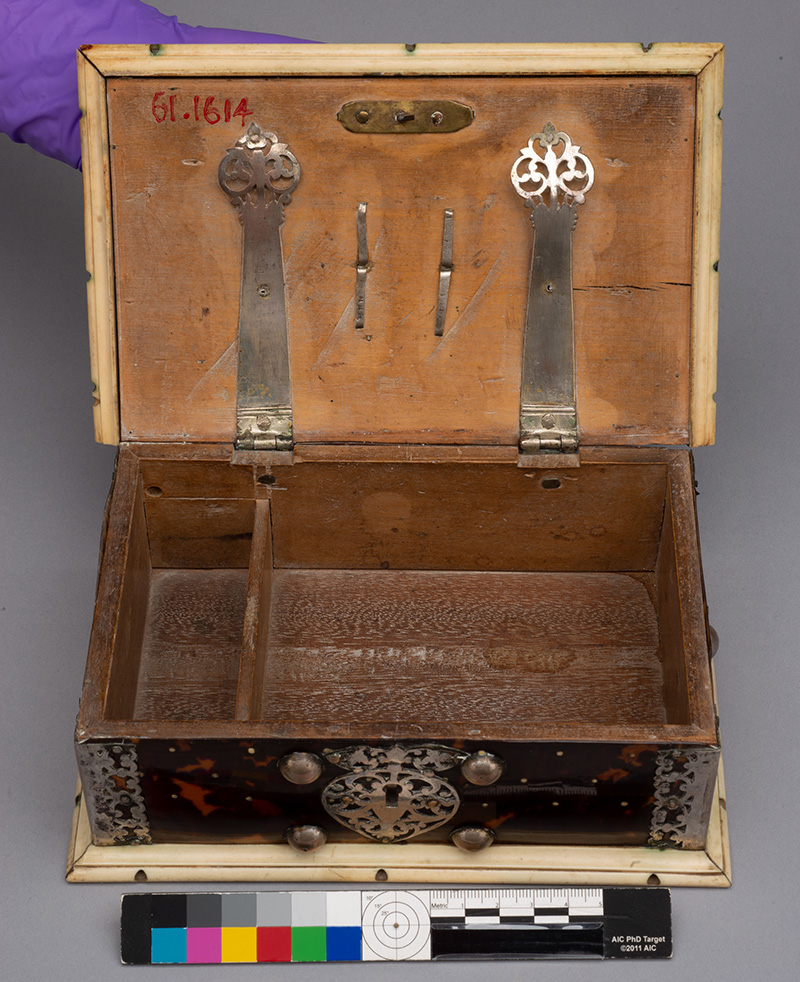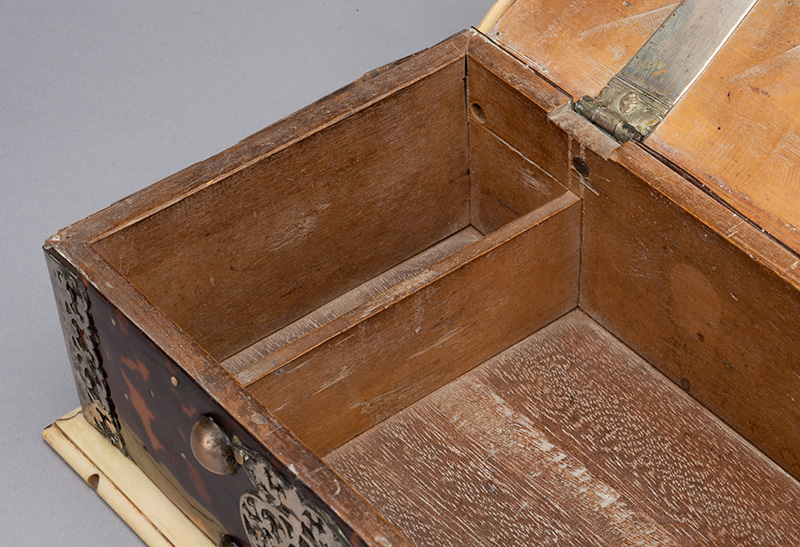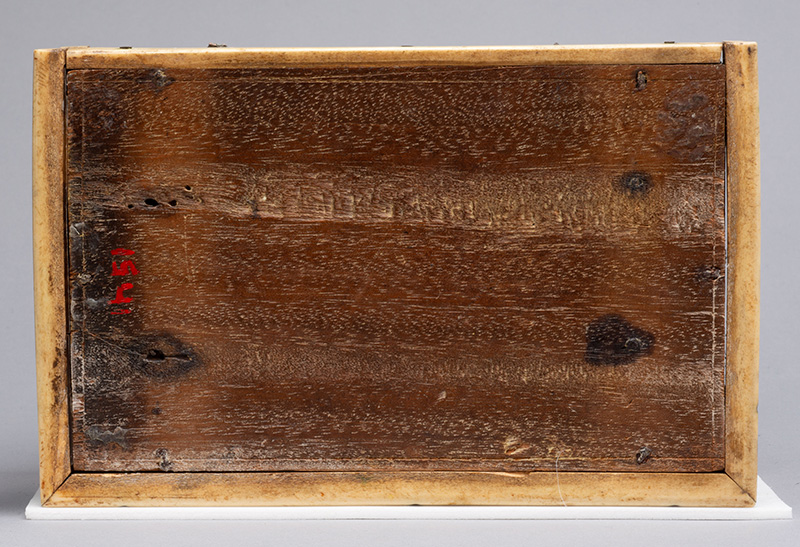H.F. du Pont’s British Tortoiseshell Box at Winterthur that Was Most Definitely Not British
by Tammy Hong
My training at Winterthur/University of Delaware Program in Art Conservation (WUDPAC) provides many opportunities to spend time examining and understanding the cultural artifacts that come across my work bench. The objects my classmates and I examine during our first year of coursework are often selected by the curators and our instructors at Winterthur because they feel further research is required to understand these artifacts’ provenance and their connections to the Winterthur collection.
I already had my suspicions about the origins of H.F. du Pont’s allegedly British tortoiseshell veneered box upon my first interaction during the organics block taught by Lara Kaplan, Objects Conservator and Affiliated Assistant Professor at WUDPAC. This tortoiseshell box was from Mr. du Pont’s personal collection, and the object’s catalog records indicate that the box dates to early 18th-century Britain.1 Tortoiseshell veneered boxes with a lock and key mechanism from Britain were often used as tea caddies. After consulting with Ann Wagner, Curator of Decorative Arts and Affiliated Assistant Professor at Winterthur, and conducting further research myself, I was able to revise these assumptions and offer further insight into this box’s provenance.
Front of Betel box, Unknown Maker. East Indies, Asia, c. 1700-1740. Tortoise Shell and Deer Bone, 1961.1614. Bequest of Henry Francis du Pont, Courtesy of Winterthur Library.
At first glance, Mr. du Pont’s tortoiseshell box is aesthetically inconsistent with British tea caddies from the 18th century, which were shaped like small chests constructed with wood (often mahogany but sometimes walnut), veneered with tortoiseshell, and decorated with ivory and horn.2 The interior of the box would have one, two, or three storage compartments to hold black tea, green tea, and utensils for tea preparation, such as a teaspoon. The interiors of tea caddies were often lined with fabric or paper to protect the tea leaves from moisture. Although Mr. du Pont’s tortoiseshell box also has a similar shape and materials, the box’s decoration includes a heavy application of metal plating and pierced work that are rarely found on British tea caddies.
Reconsidering Mr. du Pont’s tortoiseshell box beyond Britain yet within an 18th-century colonial and global historical context revealed that it was more aesthetically consistent with boxes from Dutch colonial Ceylon (modern day Sri Lanka) or Batavia (modern day Jakarta, Indonesia) that stored the elements needed for chewing the leaves and nut of the sirih plant (betel). Sirih chewing was a social custom performed during interactions between the Dutch, Indian, Sri Lankan, or Indonesian royalty in the 18th century. These boxes were shaped like small chests and were constructed using tropical hardwoods found in Southeast Asia, such as amboyna burl, or teak.3 Sirih boxes were often decorated with tortoiseshell, ivory, silver, or gold mounts, and inlaid with precious stones, ivory, or mother-of-pearl combined with substantial functional and decorative metal mounts on the exterior.
The interior compartments of these boxes stored the ingredients for sirih, which include lime, areca nut, and gambir,4 as well as tools for its preparation, such as a small knife. Though it is currently unclear how the interior of sirih boxes were divided, the interior compartments of Mr. du Pont’s box prove to be reasonable for the storage of ingredients and tools involved in sirih preparation. There are two corresponding pinholes on the left side of the interior slightly above the small compartment. This suggests the smaller compartment originally had a lid that would have helped limit the interaction between sirih ingredients and the air. The larger compartment provides adequate space for storing the tools for sirih preparation which included scissors, a small knife, and a spatula. Sirih boxes also often had legs attached to its base. The four pinholes observed on the underside of Mr. du Pont’s box indicate possible missing leg attachments.
This project demonstrates the importance of documentation in cultural heritage conservation and how our recordkeeping practices can affect the inclusivity of our approaches to collections care. If the opportunity to make inquiries into the decorative elements of Mr. du Pont’s tortoiseshell box was not provided, the box’s association with the custom of sirih chewing in 18th-century Dutch colonial Ceylon and Batavia and its affiliated communities may not have been reestablished. The revised understanding of the object’s origins and historical context enhanced the interpretation of ornamentation, possible missing components, and materiality. These new insights will inform future treatment approaches, interpretations, and decisions surrounding the display of the object.
1. The catalog entry for the object has since been revised with information compiled from this project.
2. The box’s provenance was attributed incorrectly to Britain, likely in reference to its location of purchase rather than its place of origin.
3. After consulting with Kathy Z. Gillis, Senior Furniture Conservator at Winterthur, we determined that wood identification was too invasive of an analytical technique. We were able to determine that Mr. du Pont’s tortoiseshell box was made from hardwood. Whether it is mahogany, walnut, or a tropical hardwood cannot be confirmed at this time.
4. The dried sap of the star jasmine (Jasminum multiflorum).
Tammy Hong is the National Endowment for the Humanities Graduate Fellow, Class of 2024. She lectured in the 2019 Emerging Scholars Colloquium and contributed to the winter 2018–19 issue of The Magazine of the Decorative Arts Trust.
About The Decorative Arts Trust Bulletin
Formerly known as the "blog,” the Bulletin features new research and scholarship, travelogues, book reviews, and museum and gallery exhibitions. The Bulletin complements The Magazine of the Decorative Arts Trust, our biannual members publication.
Click Images to Enlarge
Did you know that clicking on the images in Bulletin posts will allow you to get a closer look? Simply click on an image, and a larger version will open in a pop-up window.












